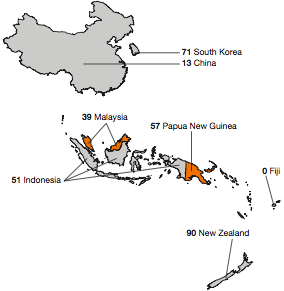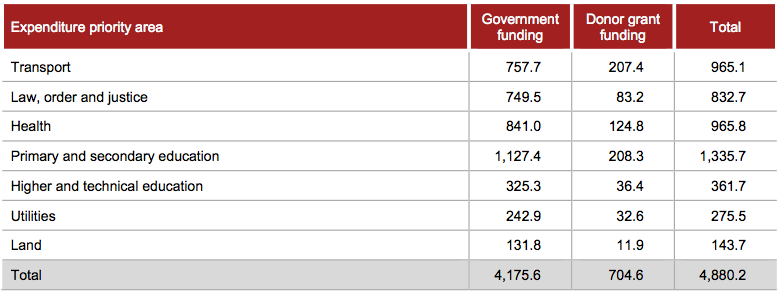PNG recently scored well in a global survey of budget transparency, including on publishing the executive budget proposal, so I was looking forward to assessing the 2011 Budget.
Every two years the International Budget Partnership carries out an independent survey of budget transparency and accountability around the world. The Open Budget Survey assesses the availability of eight key budget documents in 94 countries, as well as the comprehensiveness of the data contained in these documents. The survey also examines the extent of effective oversight provided by legislatures and supreme audit institutions, as well as the opportunities available to the public to participate in national budget decision-making processes.
Papua New Guinea’s score is 57 out of 100, which is above the average score (42) for the 94 countries surveyed. This is better than Indonesia (51) and Malaysia (39). (Note: Australia wasn’t covered in the survey, but New Zealand earned a score of 90.)
[PNG’s] score indicates that the government provides the public with some information on the central government’s budget and financial activities assessed by the Survey. The absence of full information makes it challenging for citizens to hold the government accountable for its management of the public’s money.
The report goes on to highlight the importance of budget documentation.
An executive’s budget proposal is the government’s most important policy instrument. It presents the ways the government plans to raise revenues and where these funds are allocated, thus transforming policy goals into action. In Papua New Guinea the budget proposal consists of Budget Documents Volume 1 to 3, Appropriation Bills, and the Medium Term Fiscal Strategy 2008-2012.
However, one week after PNG’s 2011 budget was handed down, the budget proposal is still not available on the PNG Treasury website. Concerned observers, other than the few who received hard copies at the budget lock-up, therefore only have access to secondhand information: either from the press or local accounting firms.
But this information is incomplete and only enables a partial analysis of the budget.
According to Treasury and Finance Minister Peter O’Neill “It is a balanced and prudent one, with record spending. The theme of the 2011 budget is to build the foundation for economic growth and prosperity.”
Spending measures in the K9.3 billion budget, as reported in the Post Courier, include:
- K1.4 billion for the education sector, including K1 billion for recurrent costs (e.g. teacher salaries, school fee subsidies) and K375.8 million for critical projects such as the rehabilitation of educational infrastructure;
- K841 million for the health sector;
- K575.7 million for the transport sector; and
- K749.5 million for the law and order sector.
That adds up to K3.5 billion funding for critical development priorities (or just over a third of the budget).
Budget analyses by PwC and Deloites contains some more information on the spending plans and from this, it emerges that just over half (53.4%) of the development and recurrent budgets is directly targeted at the seven MTDP priority areas.
This article could continue to elaborate on the 2011 budget, based on a range of press reports.
- PNG rides resource boom with big budget
- PNG analyst warns on budget implementation
- PNG presents largest budget ever
- Education gets the cherry
But we shouldn’t have to piece together the puzzle, and so this article concludes with some observations, based on readily available information, on what appears to be missing.
First, there is hardly any analysis of the 2010 budget outturn – i.e. how actual spending compared to what was planned. We know from reports that there was a supplementary budget of K653.3 million, but without easy access to the government’s budget documents, you cannot see what was spent last year in each sector.
Secondly, there is little medium term analysis. All of the reports that we have seen focus mainly on spending plans for the next year. But we know that service delivery is a multi-year undertaking – investments take time to be delivered, recruiting new staff is an ongoing commitment. Without easy access to the government’s budget documents, you cannot see how well funded these commitments are over the next five years.
Thirdly, there are few details. All the reports contain headline budget numbers for planned spending, but little or nothing on how this funding will reach service delivery units and how it will be translated into services. Based on this, it is very difficult for you to form an accurate assessment of the likelihood that the extra funding will translate into better services and outcomes.
Pouring over PNG’s budget documents isn’t most people’s idea of fun, yet it is an essential part of enabling concerned citizens to hold their government accountable. The PNG press and local accounting firms have given us a taste of what was in the 2011 budget proposal, but Treasury have let us down by not publishing the full document on their website. This is a shame: PNG had recently scored well on budget transparency and the 2011 Budget is critical to the country’s development prospects.
Matthew Morris is the Deputy Director of the Development Policy Centre at the Crawford School, ANU.
Update: Since this article was published, the PNG Parliament passed the 2011 Budget on 23 November. Treasury published the executive’s budget proposal on their website on 24 November.




Leave a Comment